动词ing形式作状语35983
- 格式:doc
- 大小:21.00 KB
- 文档页数:4
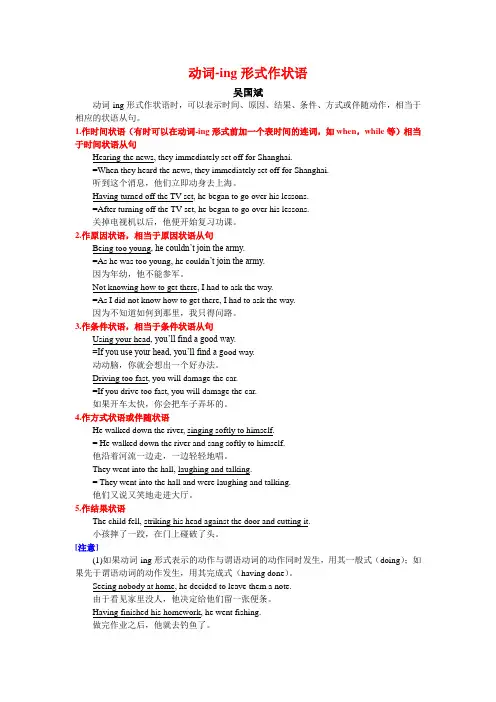
动词-ing形式作状语吴国斌动词-ing形式作状语时,可以表示时间、原因、结果、条件、方式或伴随动作,相当于相应的状语从句。
1.作时间状语(有时可以在动词-ing形式前加一个表时间的连词,如when,while等)相当于时间状语从句Hearing the news, they immediately set off for Shanghai.=When they heard the news, they immediately set off for Shanghai.听到这个消息,他们立即动身去上海。
Having turned off the TV set, he began to go over his lessons.=After turning off the TV set, he began to go over his lessons.关掉电视机以后,他便开始复习功课。
2.作原因状语,相当于原因状语从句Being too young, he couldn’t join the army.=As he was too young, he couldn’t join the army.因为年幼,他不能参军。
Not knowing how to get there, I had to ask the way.=As I did not know how to get there, I had to ask the way.因为不知道如何到那里,我只得问路。
3.作条件状语,相当于条件状语从句Using your head, you’ll find a good way.=If you use your head, you’ll find a g ood way.动动脑,你就会想出一个好办法。
Driving too fast, you will damage the car.=If you drive too fast, you will damage the car.如果开车太快,你会把车子弄坏的。

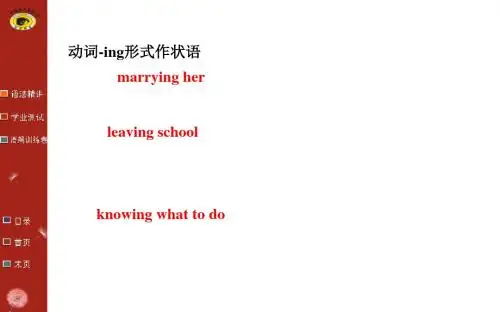
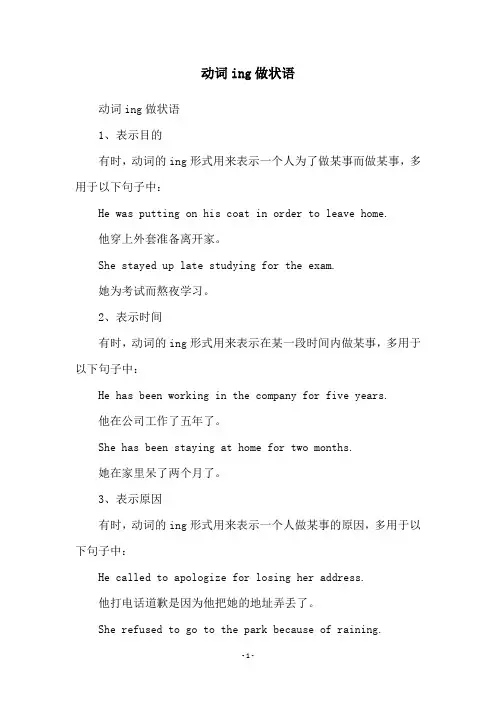
动词ing做状语
动词ing做状语
1、表示目的
有时,动词的ing形式用来表示一个人为了做某事而做某事,多用于以下句子中:
He was putting on his coat in order to leave home.
他穿上外套准备离开家。
She stayed up late studying for the exam.
她为考试而熬夜学习。
2、表示时间
有时,动词的ing形式用来表示在某一段时间内做某事,多用于以下句子中:
He has been working in the company for five years.
他在公司工作了五年了。
She has been staying at home for two months.
她在家里呆了两个月了。
3、表示原因
有时,动词的ing形式用来表示一个人做某事的原因,多用于以下句子中:
He called to apologize for losing her address.
他打电话道歉是因为他把她的地址弄丢了。
She refused to go to the park because of raining.
她因为下雨而拒绝去公园。

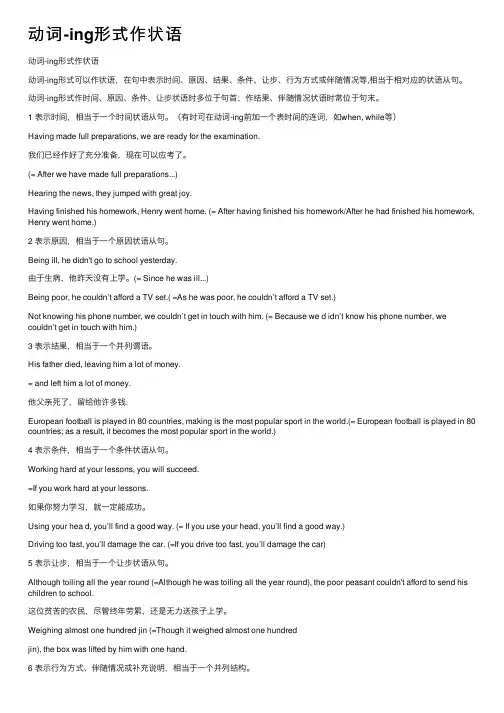
动词-ing形式作状语动词-ing形式作状语动词-ing形式可以作状语,在句中表⽰时间、原因、结果、条件、让步、⾏为⽅式或伴随情况等,相当于相对应的状语从句。
动词-ing形式作时间、原因、条件、让步状语时多位于句⾸;作结果、伴随情况状语时常位于句末。
1 表⽰时间,相当于⼀个时间状语从句。
(有时可在动词-ing前加⼀个表时间的连词,如when, while等)Having made full preparations, we are ready for the examination.我们已经作好了充分准备,现在可以应考了。
(= After we have made full preparations...)Hearing the news, they jumped with great joy.Having finished his homework, Henry went home. (= After having finished his homework/After he had finished his homework, Henry went home.)2 表⽰原因,相当于⼀个原因状语从句。
Being ill, he didn't go to school yesterday.由于⽣病,他昨天没有上学。
(= Since he was ill...)Being poor, he couldn’t afford a TV set.( =As he was poor, he couldn’t afford a TV set.)Not knowing his phone number, we couldn’t get in touch with him. (= Because we d idn’t know his phone number, we couldn’t get in touch with him.)3 表⽰结果,相当于⼀个并列谓语。
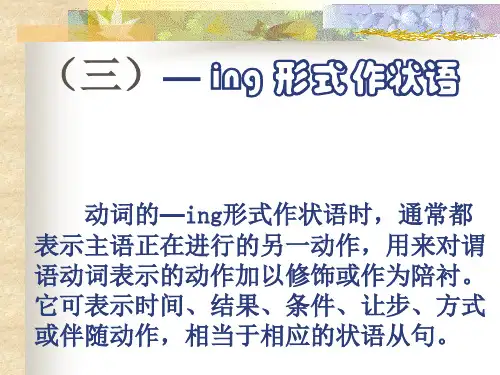
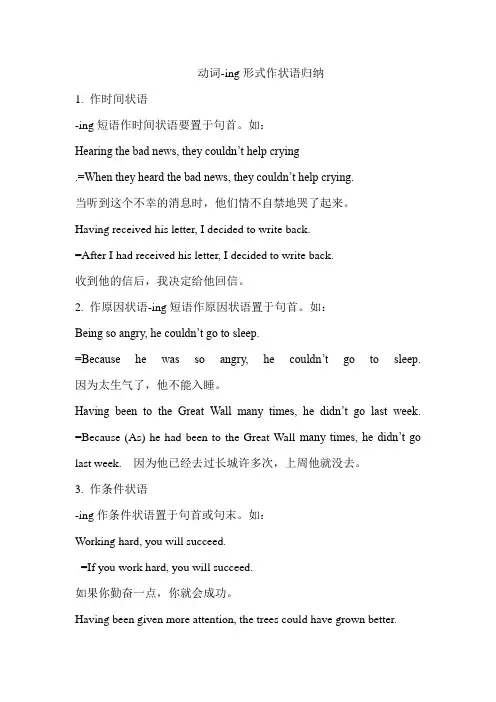
动词-ing形式作状语归纳1. 作时间状语-ing短语作时间状语要置于句首。
如:Hearing the bad news, they couldn’t help crying.=When they heard the bad news, they couldn’t help crying.当听到这个不幸的消息时,他们情不自禁地哭了起来。
Having received his letter, I decided to write back.=After I had received his letter, I decided to write back.收到他的信后,我决定给他回信。
2. 作原因状语-ing短语作原因状语置于句首。
如:Being so angry, he couldn’t go to sleep.=Because he was so angry, he couldn’t go to sleep. 因为太生气了,他不能入睡。
Having been to the Great Wall many times, he didn’t go last week. =Because (As) he had been to the Great Wall many times, he didn’t go last week. 因为他已经去过长城许多次,上周他就没去。
3. 作条件状语-ing作条件状语置于句首或句末。
如:Working hard, you will succeed.=If you work hard, you will succeed.如果你勤奋一点,你就会成功。
Having been given more attention, the trees could have grown better.=If they had been given more attention, the trees could have grown better. 如果对这些树再多注意些,它们可能长得更好。

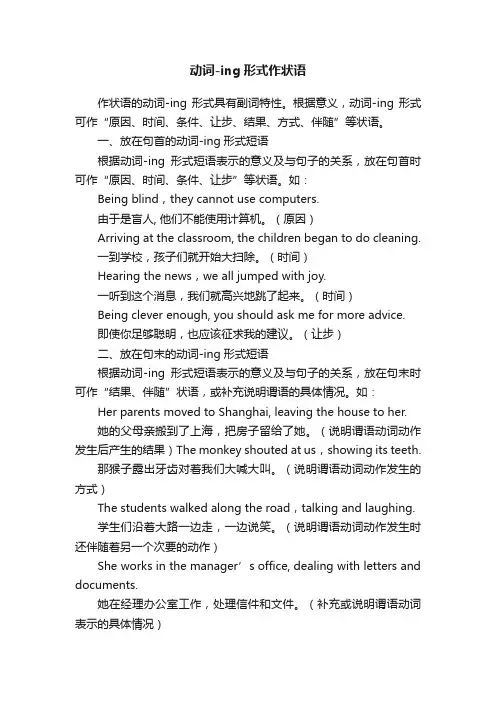
动词-ing形式作状语作状语的动词-ing形式具有副词特性。
根据意义,动词-ing形式可作“原因、时间、条件、让步、结果、方式、伴随”等状语。
一、放在句首的动词-ing形式短语根据动词-ing形式短语表示的意义及与句子的关系,放在句首时可作“原因、时间、条件、让步”等状语。
如:Being blind,they cannot use computers.由于是盲人, 他们不能使用计算机。
(原因)Arriving at the classroom, the children began to do cleaning.一到学校,孩子们就开始大扫除。
(时间)Hearing the news,we all jumped with joy.一听到这个消息,我们就高兴地跳了起来。
(时间)Being clever enough, you should ask me for more advice.即使你足够聪明,也应该征求我的建议。
(让步)二、放在句末的动词-ing形式短语根据动词-ing形式短语表示的意义及与句子的关系,放在句末时可作“结果、伴随”状语,或补充说明谓语的具体情况。
如:Her parents moved to Shanghai, leaving the house to her.她的父母亲搬到了上海,把房子留给了她。
(说明谓语动词动作发生后产生的结果)The monkey shouted at us,showing its teeth.那猴子露出牙齿对着我们大喊大叫。
(说明谓语动词动作发生的方式)The students walked along the road,talking and laughing.学生们沿着大路一边走,一边说笑。
(说明谓语动词动作发生时还伴随着另一个次要的动作)She works in the manager’s office, dealing with letters and documents.她在经理办公室工作,处理信件和文件。
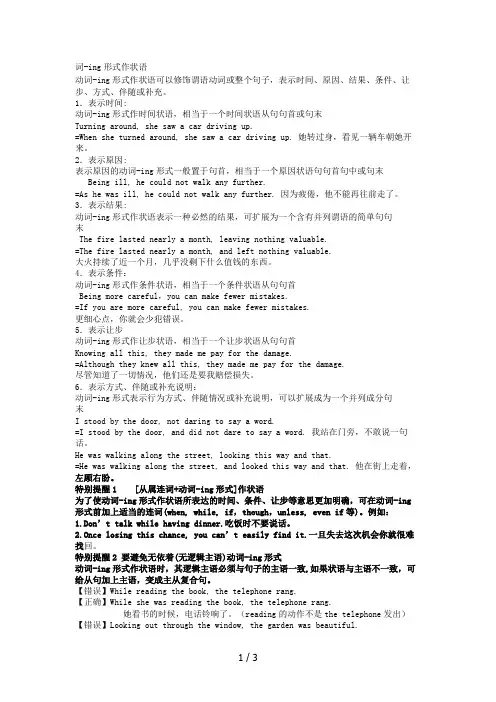
词-ing形式作状语动词-ing形式作状语可以修饰谓语动词或整个句子,表示时间、原因、结果、条件、让步、方式、伴随或补充。
1.表示时间:动词-ing形式作时间状语,相当于一个时间状语从句句首或句末Turning around, she saw a car driving up.=When she turned around, she saw a car driving up. 她转过身,看见一辆车朝她开来。
2.表示原因:表示原因的动词-ing形式一般置于句首,相当于一个原因状语句句首句中或句末Being ill, he could not walk any further.=As he was ill, he could not walk any further. 因为疲倦,他不能再往前走了。
3.表示结果:动词-ing形式作状语表示一种必然的结果,可扩展为一个含有并列谓语的简单句句末The fire lasted nearly a month, leaving nothing valuable.=The fire lasted nearly a month, and left nothing valuable.大火持续了近一个月,几乎没剩下什么值钱的东西。
4.表示条件:动词-ing形式作条件状语,相当于一个条件状语从句句首Being more careful,you can make fewer mistakes.=If you are more careful, you can make fewer mistakes.更细心点,你就会少犯错误。
5.表示让步动词-ing形式作让步状语,相当于一个让步状语从句句首Knowing all this, they made me pay for the damage.=Although they knew all this, they made me pay for the damage.尽管知道了一切情况,他们还是要我赔偿损失。
30.动词的-ing形式作状语动词的-ing形式作状语吴国斌动词的-ing形式作状语时,表示的动作是主语动作的一部分,用来修饰谓语动词,常表示动作发生的时间、原因、条件、结果、方式、伴随、让步等情况,并可以转换成相应的状语从句或并列句。
1.表时间Walking in the park,she saw an old friend.在公园散步时,她看到一个老朋友。
=When she was walking in the park, she saw an old friend.Having finished the work, he went out to meet his friends.完成工作后,他出去会朋友了。
=After he finished the work, he went out to meet his friends.2.表原因Having traveled to many places, he knows a lot.到过很多的地方去旅游,他知道的很多。
=Since he has traveled to many places, he knows a lot.Being ill, he was sent to hospital.由于生病,他被送往医院。
=Because he was ill, he was sent to hospital.3.表伴随或方式He sent me an e-mail, hoping to get further information.他给我发了封电子邮件,希望得到更多的消息。
=He sent me an e-mail, and (he) hoped to get further information.4.表条件Going there by plane, you’ll arrive tomorrow morning.如果你乘飞机去那里的话,明天早上就会到。
动词ing在句末作状语动词ing在句末作状语,通常用于表达动作或状态与主句谓语同时进行或补充说明其目的、原因、结果等。
以下是一些例句:1. She walked out of the room, humming a tune.她哼着曲子走出了房间。
2. He's studying for the exam, using flashcards.他正在用闪卡复习考试内容。
3. They left the party early, feeling tired.他们感到疲倦,就早早离开了派对。
4. I calmed myself down, taking deep breaths.我通过深呼吸使自己冷静下来。
5. The children played happily, laughing and running around.孩子们开心地玩耍着,笑着、跑来跑去。
6. He answered the phone, talking softly.他接起电话,轻声交谈。
7. The dog watched eagerly, wagging its tail.狗兴致勃勃地观察着,摇着尾巴。
8. She left the house in a hurry, leaving the door wide open.她匆忙离开屋子,把门敞开着。
9. They walked home, holding hands.他们手牵手走回家。
10. The car stopped suddenly, screeching to a halt.车突然停下来,发出刺耳的刹车声。
11. He finished his dinner, burping loudly.他吃完晚饭,打了一个响亮的饱嗝。
12. She tripped on the stairs, tumbling down to the bottom.她在楼梯上绊倒了,摔倒了底部。
动词的-ing形式作状语一、动词的-ing形式作状语时,通常都表示主语正在进行的另一动作,用来对谓语动词表示的动作加以修饰或作为陪衬。
它可表示时间、原因、结果、条件、让步、方式或伴随动作,相当于相对应的状语从句。
二、注:从句的主语和主句的主语必须一致。
即-ing分词作状语时,它的逻辑主语就是整个句子的主语,并表示主动的关系。
三、1.表示时间,代替时间状语从句Walking in the street, I met a friend of mine.=When I walked in the street, I met a friend of mine.2. 表示原因,相当于一个原因状语从句,多置于句首或句末,也可置于句中She rang him up, hoping to get his support.= As she hoped to get his support, she rang him up.Being ill, he didn’t go to school=As he was ill, he didn’t go to school3.表示条件,多置于句首Working hard, you will succeed.=If you word hard, you will succeed.4.表示让步,多置于句首Being poor, the old man was happy.=Though he was poor, the old man was happy.5.表示结果,常置于句末The boy fell off his bike, breaking his right arm.= The boy fell off his bike, so he broke his right arm.6.表示方式或伴随,多置于句末,也可置于句首1) He sat at the table, reading a magazine.2) Laughing and talking, they went into the room.四、为强调与谓语动词的动作同时发生,在-ing形式短语前可用连词when, while等;为强调在谓语动词的动作之前或之后发生,在-ing形式短语前可用连词before或aftere.g. 1) Be careful when crossing the road.2) Don’t laugh while eating.3) Before going abroad, he lived here.4) After watching TV, he went to bed.五、在-ing形式短语前可用介词on,表示“一……就……”e.g. On arriving in Beijing, he went to see his uncle.(= As soon as he arrived in Beijing, he went to see his uncle.)。
非谓语动词用法解析动词ing作目的状语非谓语动词用法解析:动词-ing作目的状语动词-ing作目的状语是非谓语动词的一种常见用法。
在句子中,动词-ing形式可以作为目的状语,表示主语的动作或状态的目的或用途。
本文将对非谓语动词-ing作目的状语的用法进行详细解析。
一、形式动词-ing作目的状语的形式为动词的现在分词形式,即动词原形 + ing。
例如:1. I went shopping to buy some groceries.我去购物是为了买些杂货。
2. She stayed up late to finish her project.她熬夜是为了完成她的项目。
3. They studied hard to pass the exam.他们努力学习是为了通过考试。
二、用法1. 表示主语的目的或用途动词-ing作目的状语可以说明主语进行某个动作或处于某种状态的目的或用途。
例如:1. They traveled to experience different cultures.他们旅行是为了经历不同的文化。
2. The students worked hard to earn good grades.学生们努力学习是为了获得好成绩。
3. He went to the gym to build muscle.他去健身房是为了增肌肉。
2. 与动词不定式互换有些句子可以使用动词-ing作目的状语或动词不定式作目的状语,表示相同的意思。
这时候,动词-ing往往更常用于口语或非正式场合。
例如:1. He went to the store to buy milk. 或 He went to the store buying milk.他去商店是为了买牛奶。
2. She came to the party to meet new people. 或 She came to the party meeting new people.她来参加派对是为了结识新的人。
ing分词作状语用法"ing"分词作状语是指将动词的现在分词形式作为句子中的状语,用来修饰句子的主语、谓语、宾语或整个句子。
"ing"分词作状语时可以表达时间、原因、方式、结果等不同的含义。
有以下几种常见的用法:1. 时间状语:表示主动的动作与谓语动词同时进行,或者谓语动作在其之后发生。
例如:- Walking in the park, I saw a beautiful flower. (当我在公园里散步时,我看到了一朵美丽的花。
)- After finishing my homework, I went to bed. (完成作业后,我去睡觉了。
)2. 原因状语:表示动词的原因或理由。
例如:- Being tired, she decided to take a nap. (因为累了,她决定小睡一会儿。
)- Knowing that she was late, he ran to catch the bus. (知道她迟到了,他跑去赶公车。
)3. 方式状语:表示动作的执行方式或方式特征。
例如:- She spoke to the audience, using simple and clear language. (她向观众们讲话时,使用简单明了的语言。
)- He drove home, carefully avoiding any traffic violations. (他小心地开车回家,避免任何交通违章。
)4. 结果状语:表示主句动作的结果。
例如:- The wind was blowing, making the trees sway. (风吹得树木摇摆不定。
)- The girl fell off her bike, hurting her knee. (女孩从自行车上摔下来,伤到了膝盖。
)需要注意的是,"ing"分词作状语时,一般位于句子的开头或中间,与句子的主语之间不加逗号分隔。
词-ing形式作状语动词-ing形式作状语可以修饰谓语动词或整个句子,表示时间、原因、结果、条件、让步、方式、伴随或补充。
1.表示时间:动词-ing形式作时间状语,相当于一个时间状语从句。
句首或句末 Turning around, she saw a car driving up.=When she turned around, she saw a car driving up.她转过身,看见一辆车朝她开来。
2.表示原因:表示原因的动词-ing形式一般置于句首,相当于一个原因状语从句。
句首句中或句末 Being ill, he could not walk any further.=As he was ill, he could not walk any further.因为疲倦,他不能再往前走了。
3.表示结果:动词-ing形式作状语表示一种必然的结果,可扩展为一个含有并列谓语的简单句。
句末 The fire lasted nearly a month, leaving nothing valuable.=The fire lasted nearly a month, and left nothing valuable.大火持续了近一个月,几乎没剩下什么值钱的东西。
4.表示条件:动词-ing形式作条件状语,相当于一个条件状语从句。
句首 Being more careful, you can make fewer mistakes.=If you are more careful, you can make fewer mistakes.更细心点,你就会少犯错误。
5.表示让步动词-ing形式作让步状语,相当于一个让步状语从句。
句首 Knowing all this, they made me pay for the damage.=Although they knew all this, they made me pay for the damage.尽管知道了一切情况,他们还是要我赔偿损失。
6.表示方式、伴随或补充说明:动词-ing形式表示行为方式、伴随情况或补充说明,可以扩展成为一个并列成分。
句末 I stood by the door, not daring to say a word.=I stood by the door, and did not dare to say a word.我站在门旁,不敢说一句话。
He was walking along the street, looking this way and that.=He was walking along the street, and looked this way and that. 他在街上走着,左顾右盼。
特别提醒1 [从属连词+动词-ing形式]作状语为了使动词-ing形式作状语所表达的时间、条件、让步等意思更加明确,可在动词-ing形式前加上适当的连词(when, while, if,though,unless, evenif等)。
例如:1.Don’t talk while having dinner.吃饭时不要说话。
2.Once losing this chance, you can’t easily find it.一旦失去这次机会你就很难找回。
特别提醒2 要避免无依着(无逻辑主语)动词-ing形式动词-ing形式作状语时,其逻辑主语必须与句子的主语一致,如果状语与主语不一致,可给从句加上主语,变成主从复合句。
例如:【错误】While reading the book, the telephone rang.【正确】While she was reading the book, the telephone rang.她看书的时候,电话铃响了。
(reading的动作不是the telephone发出)【错误】Looking out through the window, the garden was beautiful. 【正确】Looking out through the window, we found a beautiful garden.从窗户里,我们看见一个漂亮的花园。
(looking的动作不是garden发出)特别提醒3 独立动词-ing形式作状语英语中有些动词-ing形式,如generally speaking, judging from…,c**idering…, talking of…,supposing…等,它们作状语时的逻辑主语可以和句子的主语不一致。
这种形式已经成为固定的用法。
例如:Supposing he is ill, who will do the work? 假如他病了,谁来做这工作呢?Generally speaking, boys are more interested in science than girls. 一般来说,男孩比女孩对科学更感兴趣。
词-ing形式作状语考点聚焦动词-ing形式作状语可以修饰谓语动词或整个句子,表示时间、原因、结果、条件、让步、方式、伴随或补充。
1.表示时间:动词-ing形式作时间状语,相当于一个时间状语从句。
句首或句末 Turning around, she saw a car driving up.=When she turned around, she saw a car driving up.她转过身,看见一辆车朝她开来。
2.表示原因:表示原因的动词-ing形式一般置于句首,相当于一个原因状语从句。
句首句中或句末 Being ill, he could not walk any further.=As he was ill, he could not walk any further.因为疲倦,他不能再往前走了。
3.表示结果:动词-ing形式作状语表示一种必然的结果,可扩展为一个含有并列谓语的简单句。
句末 The fire lasted nearly a month, leaving nothing valuable.=The fire lasted nearly a month, and left nothing valuable.大火持续了近一个月,几乎没剩下什么值钱的东西。
4.表示条件:动词-ing形式作条件状语,相当于一个条件状语从句。
句首 Being more careful, you can make fewer mistakes.=If you are more careful, you can make fewer mistakes.更细心点,你就会少犯错误。
5.表示让步动词-ing形式作让步状语,相当于一个让步状语从句。
句首 Knowing all this, they made me pay for the damage.=Although they knew all this, they made me pay for the damage.尽管知道了一切情况,他们还是要我赔偿损失。
6.表示方式、伴随或补充说明:动词-ing形式表示行为方式、伴随情况或补充说明,可以扩展成为一个并列成分。
句末 I stood by the door, not daring to say a word.=I stood by the door, and did not dare to say a word.我站在门旁,不敢说一句话。
He was walking along the street, looking this way and that.=He was walking along the street, and looked this way and that. 他在街上走着,左顾右盼。
特别提醒1 [从属连词+动词-ing形式]作状语为了使动词-ing形式作状语所表达的时间、条件、让步等意思更加明确,可在动词-ing形式前加上适当的连词(when, while, if,though,unless, even if等)。
例如:1.Don’t talk while having dinner.吃饭时不要说话。
2.Once losing this chance, you can’t easily find it.一旦失去这次机会你就很难找回。
特别提醒2 要避免无依着(无逻辑主语)动词-ing形式动词-ing形式作状语时,其逻辑主语必须与句子的主语一致,如果状语与主语不一致,可给从句加上主语,变成主从复合句。
例如:【错误】While reading the book, the telephone rang.【正确】While she was reading the book, the telephone rang.她看书的时候,电话铃响了。
(reading的动作不是the telephone发出)【错误】Looking out through the window, the garden was beautiful. 【正确】Looking out through the window, we found a beautiful garden.从窗户里,我们看见一个漂亮的花园。
(looking的动作不是garden发出)特别提醒3 独立动词-ing形式作状语英语中有些动词-ing形式,如generally speaking, judging from…,c**idering…, talking of…,supposing…等,它们作状语时的逻辑主语可以和句子的主语不一致。
这种形式已经成为固定的用法。
例如:Supposing he is ill, who will do the work? 假如他病了,谁来做这工作呢?Generally speaking, boys are more interested in science than girls. 一般来说,男孩比女孩对科学更感兴趣。
注意:a. 动词-ing形式作状语,当句子的谓语动词和动词-ing形式的动词所表动作在时间上几乎同时发生时,用doing作状语,;若动词-ing形式动作发生在句子谓语动词所表示的动作之前,用其完成时having done 作状语,;动词-ing 形式的否定形式为:not doing 或者not having done,。
b. 有一些固定的动词-ing形式作状语,这就是独立成分,。
c. 当句子主语和动词-ing形式的主语不一致时,则不可省略动词-ing形式的主语。
这时可用独立主格结构,即:带有逻辑主语的动词-ing形式作状语;或者用with 复合结构作伴随状语.若分词的动作发生在谓语动词以前,则分词使用完成式:having done。